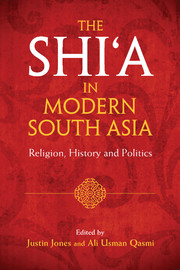Book contents
- Frontmatter
- Contents
- Preface
- Introduction
- 1 Faith Deployed for a New Shiʿi Polity in India
- 2 The Ismaʿili – Isna ʿAshari Divide Among the Khojas
- 3 Local Nodes of a Transnational Network
- 4 Shiʿism, Humanity and Revolution in Twentieth-century India
- 5 Universalising Aspirations
- 6 Muslims, Media and Mobility in the Indian Ocean Region
- 7 Shariʿa, Shiʿas and Chishtiya Revivalism
- 8 Third Wave Shiʿism
- Contributors
- Index
7 - Shariʿa, Shiʿas and Chishtiya Revivalism
Published online by Cambridge University Press: 05 May 2015
- Frontmatter
- Contents
- Preface
- Introduction
- 1 Faith Deployed for a New Shiʿi Polity in India
- 2 The Ismaʿili – Isna ʿAshari Divide Among the Khojas
- 3 Local Nodes of a Transnational Network
- 4 Shiʿism, Humanity and Revolution in Twentieth-century India
- 5 Universalising Aspirations
- 6 Muslims, Media and Mobility in the Indian Ocean Region
- 7 Shariʿa, Shiʿas and Chishtiya Revivalism
- 8 Third Wave Shiʿism
- Contributors
- Index
Summary
The significance of Sufism in various manifestations of Islamic cultures has been seminal, as a prime agency mediating between man and God and also, with particular reference to Muslim South Asia, “in mediating between man and society”. Equally important is the role of the Sufis as agents in processes of cultural hybridisation and syncretism. South Asia and particularly the Punjab, the region that forms the site of this article's exploration, have been inhabited by culturally, religiously and ethnically divergent communities, across which different Sufi traditions have historically provided a ‘gluing’ force. The Chishtiya Sufi silsilah, inaugurated in India, is particularly important in embodying an Indic pluralism while at the same time bringing “Islam to the masses and the masses towards Islam”.
This article sets out to explore the development of an exclusionary streak in the Chishtiya order after its revival in late-eighteenth century Punjab, with Nur Muhammad Muharvi (1730–1790) as its harbinger. It highlights the process whereby Chishti Sufis from this period onwards embarked on the path of excluding Shiʿas from what they regarded as the central Islamic tradition. This sectarian gulf widened further with the parallel emergence of the Usuli faction among the Shiʿa, who laid stress on the exclusivity of their community. Shiʿi deprecation of the first three Sunni Caliphs (tabarra) institutionalised this Shiʿa-Sunni alienation, which eventually snowballed into a ‘powder-keg’ situation by the last two decades of the twentieth century. While usually perceived as an ‘inclusive’ Sufi order, the process of religious reform impelled Chishti pirs to shun plurality, supposedly the central trait of their order, and instead embrace a more sectarian ethos, a trend that this article explores in relation to the sajjada nashins of Sial Sharif. It is also argued here that the emphasis placed by protagonists of the Chishtiya revival on the shariʿa (Islamic law) for the revitalisation of Muslim society acted as a conduit for the emergence of these sectarian tendencies.
- Type
- Chapter
- Information
- The Shi‘a in Modern South AsiaReligion, History and Politics, pp. 159 - 178Publisher: Cambridge University PressPrint publication year: 2015
- 1
- Cited by



